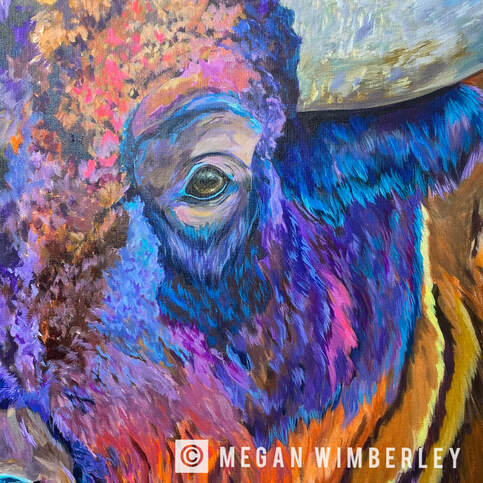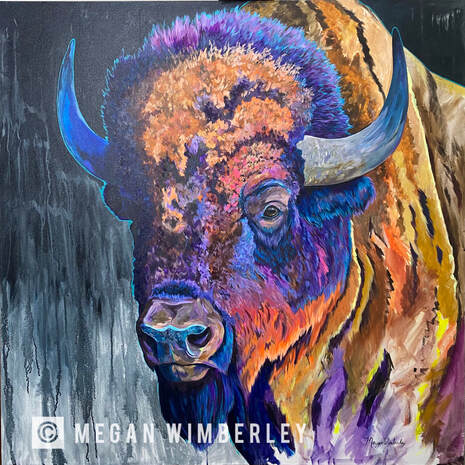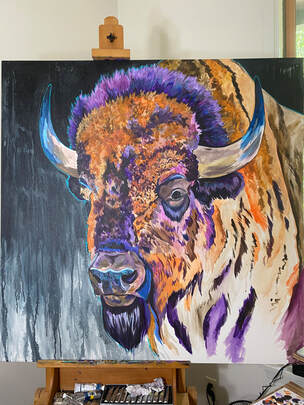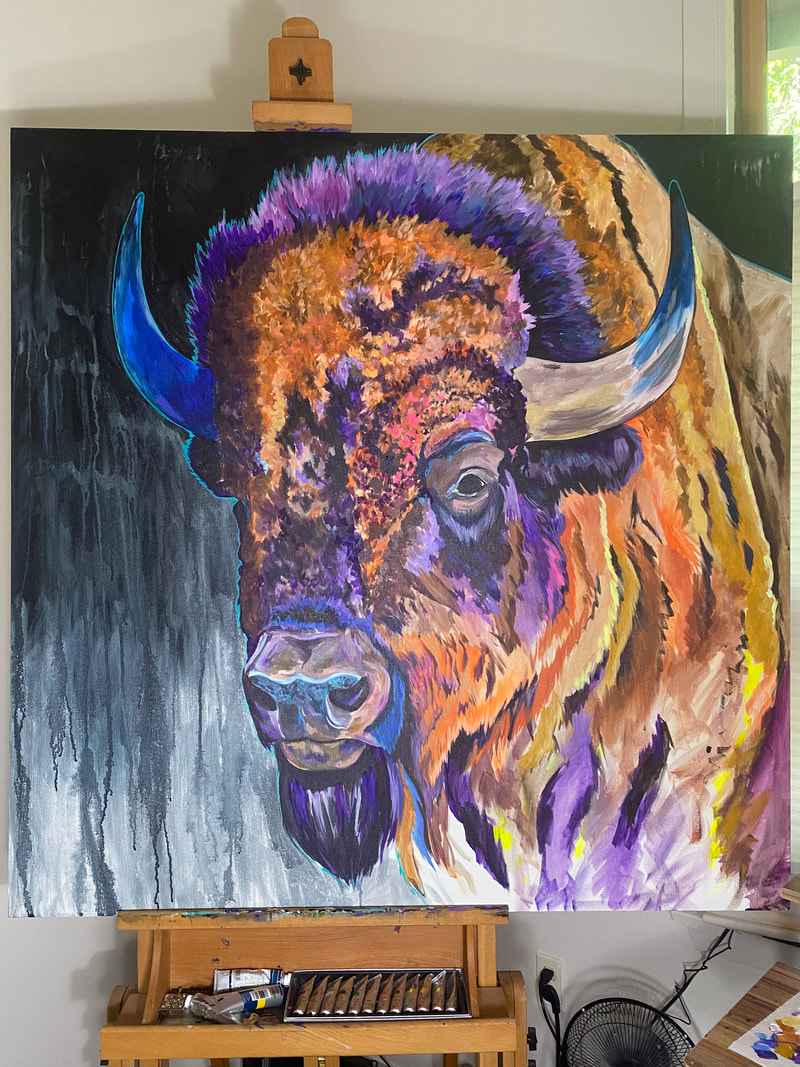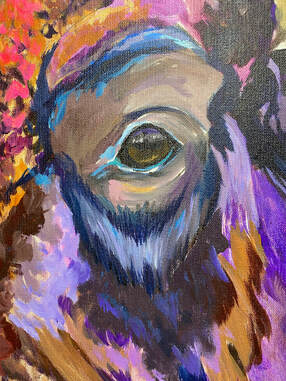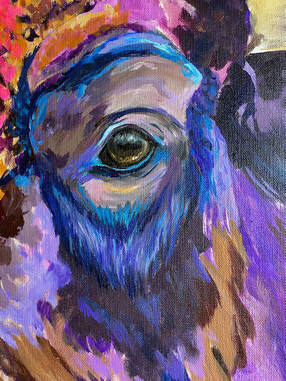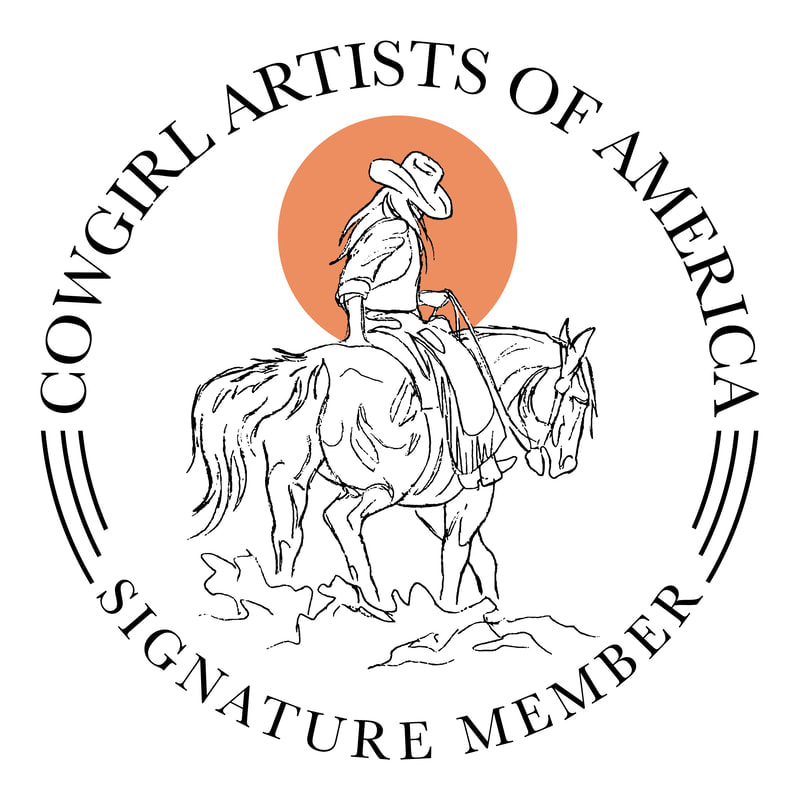|
The final stages of my painting are about finesse. At this point I'm adding the final bits of texture, and enhancing the shadows and highlights. The colors have settled where they want to be, but I'll fine tune them as well. In the photo below you can see the texture of the hair and horns, and the depth in the eye. Depending on the piece, I don't always worry about every singe portion being finely detailed. As you will see in the last photo, this painting is a mixture of loose and tight painting styles. The full photo below does not do the painting justice. This painting is very vibrant (as seen above). It has a sharp contrast between the darks and lights, and the lights really shine. In person, you can also see the subtle shifts in the shadow, such as the soft highlight on the bison's right eye). It was challenging to keep going forward, not feeling totally confident about the dark background and shadow, but it just felt right, and I'm really happy with the way it came out. The very last things I do on a painting are to clean up the sides, take photos, add varnish, and put on a wire. At this point, if I have not already named the painting I will do so. If you are interested in the specific naming of this piece take a look at this post on my Instagram account.
And if you want to read about the first steps of this painting visit Part 1, Part 2, Part 3, and Part 4 on my blog.
0 Comments
This is when painting starts to get really fun for me. I feel like in the previous stages, there is a lot of remembering to just trust the process, because the painting can often feel sloppy and ugly in the early stages. Sometimes the blocks of colors blend in with one another and the painting just feels flat and boring. But I just keep going, I just keep trusting myself and the process, and then, as I say, "the colors start to sing--" and that can happen very suddenly. I'll be working away and out of the blue, it's like, "oh, there you are!" Each layer had been building up and up and up until really beautiful things begin to happen and all the colors start to play nicely together. On this bison I did two things that really moved the painting out of the "sloppy stage." First of all, I decided that I would go forward with my inclination to push some darker shadows across the left side of the face. I was a bit anxious about doing this because I was worried about the painting feeling too heavy. Instead laying in more shadow straightaway, I continued to play with the colors on the bison more before committing. I finally decided to just go for it. I think it turned out well! What do you think? The next thing I did was begin to add more vibrant colors. I try to get the colors to play on one another, but also give them the space to breath when they need it. It's about knowing when to really push something and when to back away. At this point the bottom layers start to pop as well. This painting is big-- 48"x48", so there is also a lot of leaning in and stepping back. With big paintings it is really easy to get into the grove of painting and forget to step back and view it from a distance. Often this leads to messed up proportions or misplaced elements. Each layer had been building up and up and up until really beautiful things begin to happen and all the colors start to play nicely together. At this stage the colors I choose are very important. I'm past the stage of blocking things in. There isn't going to be a whole lot of covering up what I lay down, so paying attention to the way each color interplays with the colors around it is high priority. I'm also paying attention to the finer details of where things are, what the texture is like, and making sure that proportions don't get out of wack. At this stage the subject really starts to get more personality.
I've mentioned elsewhere that my approach to painting is conversational. What I mean by that is that it feels like the painting lets me know where it wants to go. Sure, I have put in the time and work to learn the skills, and sure I am making conscious decisions; but at the same time it is an act of communicating with what is on the canvas. I also find that as the painting progresses the subject begins to tell me more about itself. Often the animals in my paintings are symbolic, and this is where that symbolism takes shape. Previously I discussed how I start a painting, and then about laying down the base layers. The next step is to begin putting down something more solid. Every painting is different, but for this bison I began to work in some more solid colors and textures (as seen in the video). At this point I'm still looking at things in terms of generalities. I have not started putting in much detail, but what I am adding in this layer refines what was put down in the underpainting. My approach is to slowly refine, layer by layer, while allowing the colors to guide the way. At this stage the colors are still not "singing," but they are laying the foundation for my signature style. Do you have questions about this stage of the painting? Let me know in the comments. [Painting] is an act of communicating with what is on the canvas... It's all about that base.... actually, for me, it is not. The base does play an important part though. It is like the map for where things are in general terms. An underpainting is often a thin, monochromatic base layer of paint that helps to determine value. I take two different approaches to my underpainting. Sometimes I use very washy paint to lay out the background, subject, and major shadows. The other approach I take is to lay down a (not washy) layer of paint for the shadows. I then add thinner layers of paint to the subject based on what colors I think I will be using.
I rarely paint monochromatically in my underpainting, and my approach is not the traditional one. However, I often have areas where I want my underpainting to shine through with more vibrance, or to not be covered at all. Traditional approaches usually cover the entire underpainting with thicker layers of paint. My approach is to build up my painting with many layers, with the intention of various layers shining through. For this bison I did more of the first approach, but did not include quite as many shadows as I normally would. This was in part because I am considering making the painting a little more "moody" with more shadows across the face. However, I have not decided if I will do that yet, and it is always easier to go darker than it is to go lighter. To see Part 1 of this series on my process, click here. |
AuthorMegan Wimberley Archives
November 2023
|
